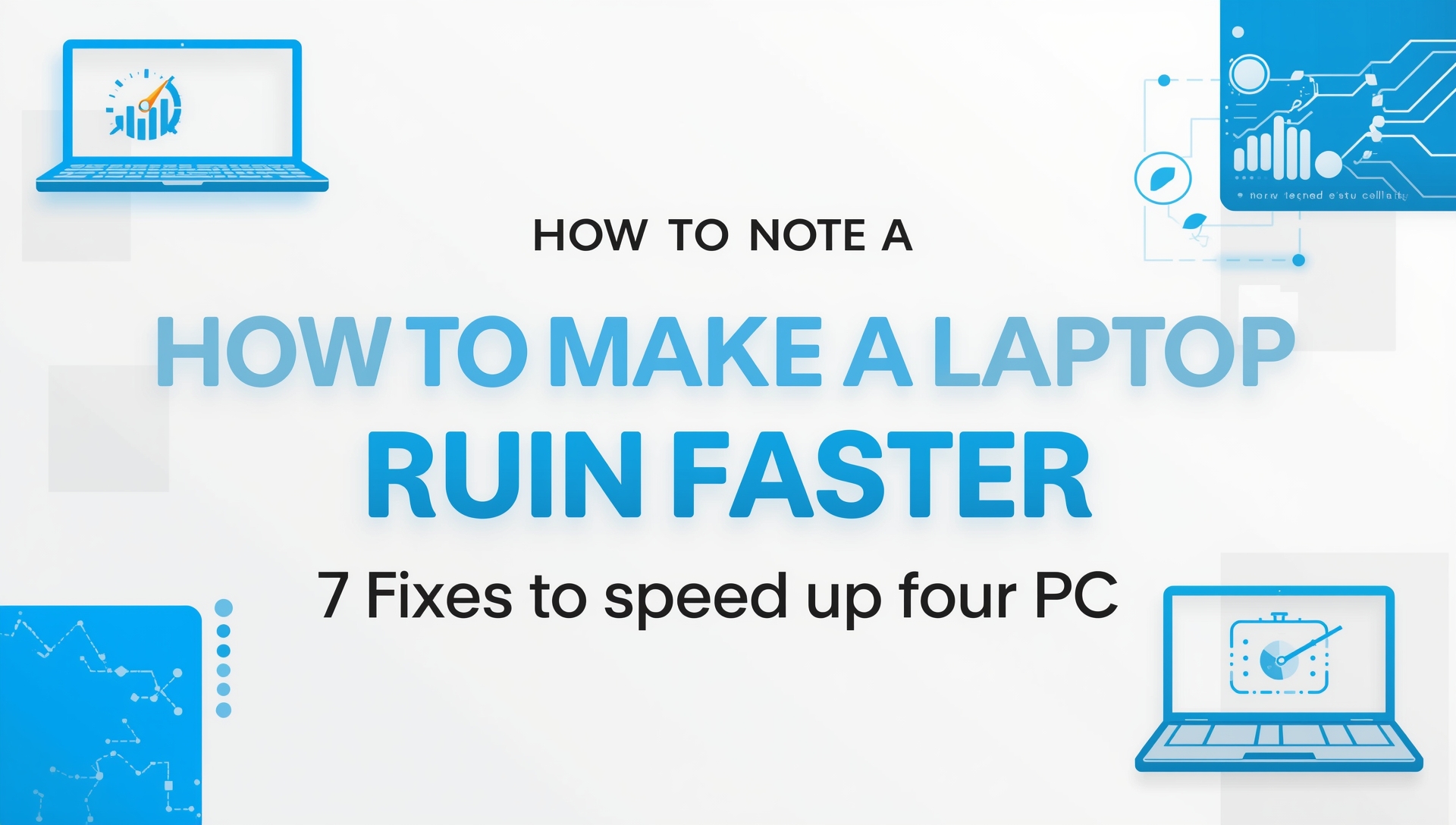
Introduction
Make A Laptop Run Faster feeling slow and sluggish, leaving you frustrated as you wait for tasks to load? You’re not alone many users experience a decline in performance over time. While upgrading hardware might seem like the go-to solution, it’s not always necessary. There are several effective ways to speed up your laptop without investing in new components. By optimizing settings, cleaning your system, and managing resources more effectively, you can enjoy a faster and more efficient notebook without the need for costly upgrades.
In this article, we’ll explore practical tips and tricks to speed up your old laptop. Whether you’re using Windows 10 or an earlier version, there are actionable steps you can take right now to restore your laptop’s performance.
Overview
Make A Laptop Run Faster A slow laptop can significantly hinder your productivity. Whether you use your device for work, entertainment, or casual browsing, a sluggish laptop can cause constant frustration. The good news is that improving your laptop’s speed doesn’t always require hardware upgrades. By focusing on software optimization and effective maintenance practices, you can get your computer running faster in no time.Make A Laptop Run Faster
From clearing out unnecessary files to managing startup processes and optimizing system settings, these techniques are simple and free. In this guide, we’ll take you through detailed steps to optimize your PC’s performance for free and boost its overall performance.
Detailed Section
1. Free Up Disk Space
One of the primary reasons for slow laptop performance is a cluttered hard drive. Over time, files accumulate, and unnecessary data hogs valuable storage space, causing the system to slow down.
- Delete Temporary Files: Windows often accumulates temporary files that aren’t necessary for system operations. You can manually delete them or use the built-in Disk Cleanup tool to remove them in a few clicks.
- Uninstall Unused Programs: Review the list of installed programs and uninstall any that you no longer need. This can free up space and reduce background processes that consume system resources.
- Move Files to Cloud or External Storage: If your hard drive is nearing capacity, consider storing large files, such as videos and photos, on cloud services (e.g., Google Drive, Dropbox) or an external hard drive.
2. Disable Startup Programs
Many programs are set to launch automatically when your laptop boots up, consuming system resources and slowing down performance. Disabling unnecessary startup programs can significantly improve your laptop’s performance.
- Use Task Manager: Press Ctrl + Shift + Esc to open Task Manager and navigate to the Startup tab. Here, you can turn off programs that you don’t need to run at startup, such as auto-updates or software that you rarely use.
- Limit Background Applications: Be mindful of background applications that may be running unnecessarily. Some apps continue to use system resources even when they aren’t active.
3. Optimize System Settings
There are a few tweaks you can make within Windows settings to help speed up Windows 10 with one command or through a few clicks.
- Adjust Power Settings: Set your laptop to “High Performance” mode in the Power Options section of the Control Panel. This ensures your computer uses its full processing power when needed.Speed Up Your Laptop
- Turn Off Visual Effects: Fancy animations and visual effects might look nice, but they can drain system resources. Go to System Properties > Advanced System Settings > Settings under the Performance tab and select “Adjust for best performance.”
- Enable Storage Sense: Windows 10 includes a feature called Storage Sense, which automatically deletes temporary files and manages disk space when it reaches a certain threshold. Please enable it in Settings > System > Storage.Make A Laptop Run Faster
4. Update Software and Drivers
Running outdated software or device drivers can hinder performance. Keeping everything up to date ensures compatibility with the latest performance enhancements and bug fixes.
- Update Windows: Regularly check for Windows updates in Settings > Update & Security. These updates often include performance improvements and security patches.
- Update Drivers: Outdated hardware drivers can cause slowdowns and errors. Use Device Manager to check for and update drivers, especially for graphics, sound, and network cards.
5. Scan for Malware and Bloatware
Malware or unwanted software can drain system resources, causing your laptop to slow down. It’s essential to scan for viruses and remove any pre-installed bloatware on your computer.Speed Up Your Laptop
- Run Antivirus Software: Perform a full system scan with reliable antivirus software. You can also use Windows Defender, which is built into Windows 10, to scan for malware and other threats.
- Remove Bloatware: Many laptops come with pre-installed software that you may never use. Use the Add or Remove Programs feature to uninstall these applications and free up system resources.Make A Laptop Run Faster
6. Upgrade Storage (Optional)
If you’ve tried everything else and your laptop is still slow, consider upgrading to a Solid State Drive (SSD). While this involves hardware changes, it’s one of the most effective ways to dramatically improve system performance. An SSD is faster than a traditional hard drive, resulting in quicker boot times and more rapid file access.
7. Use Performance Tools and Utilities
Many third-party tools and utilities are designed to enhance system performance. These tools can help you identify issues and optimize your laptop’s settings for improved performance and speed.Make A Laptop Run Faster
- CCleaner: A popular tool for cleaning up your system by removing junk files, browser history, and broken registry entries.
- Advanced SystemCare: This software offers a range of optimization features, including disk cleanup, privacy protection, and performance boosting.
Benefits of Speeding Up Your Laptop Without Upgrading Hardware
Optimizing your laptop without upgrading hardware comes with several benefits, including:Make A Laptop Run Faster
- Cost Savings: Avoiding unnecessary hardware upgrades can save you money. You can achieve significant performance improvements without incurring expenses for new parts.
- Extended Laptop Lifespan: Regular maintenance and optimization can extend the lifespan of your laptop, keeping it running smoothly for years to come.
- Improved User Experience: A faster laptop means a more responsive device, improving your overall user experience when working, gaming, or browsing.
- Reduced Downtime: When your computer runs faster, you spend less time waiting for applications to load or files to open, resulting in higher productivity.Make A Laptop Run Faster
FAQ Section
1. How can I speed up my PC for free?
To speed up my PC, I can clear out unnecessary files, disable startup programs, adjust system settings, and scan for malware.Make A Laptop Run Faster
2. Can I speed up Windows 10 with one command?Make A Laptop Run Faster
Yes, you can speed up Windows 10 with a single command by running the Disk Cleanup tool or using the Storage Sense feature to clean up temporary files automatically.Make A Laptop Run Faster
3. What’s the best way to speed up your old laptop without upgrading hardware?
To speed up your old laptop, try freeing up disk space, turning off unnecessary startup programs, optimizing system settings, and removing unnecessary software.Make A Laptop Run Faster
4. How often should I clean my laptop to maintain its speed?
It’s a good idea to clean your laptop every few months by deleting temporary files, updating software, and scanning for viruses to maintain optimal speed.Make A Laptop Run Faster
5. What are some quick fixes to improve my laptop’s performance?
Some quick fixes include clearing the cache and temporary files, turning off unwanted background programs, and ensuring that your system and drivers are up to date. Make A Laptop Run Faster
Final Thoughts
Improving the speed of your laptop doesn’t require costly hardware upgrades. By following the steps outlined in this guide, you can optimize your system, remove unnecessary files, and ensure that everything is running efficiently. Regular maintenance goes a long way in keeping your laptop performing optimally for years to come.
By implementing these strategies, you can enjoy a faster, more responsive laptop without breaking the bank.



